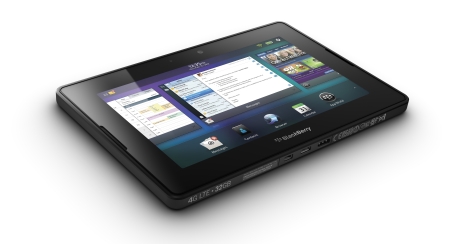Research In Motion is about to catch up with competitors offering tablets with cellular connectivity. The company said Thursday that its LTE BlackBerry PlayBook tablet will be released Aug. 9 in Canada and shortly afterwards in other countries.
However, it isn’t clear whether adding the capability to use the 7-inch tablet on a high-speed network will spur sales of the device. The Wi-Fi only versions of the tablet, introduced over a year ago, haven’t sold well and RIM has been forced to heavily discount
them. On the other hand, cellular offers always-on connectivity and — as long as there’s wide coverage — the ability to keep it on in a moving vehicle. With Wi-Fi there has to be an access point nearby.
“The tablet market is quite competitive,” acknowledged Shaun Coghlan, a PlayBook senior product manager. “But this is RIM’s first LTE product. We’re showing the innovation in the company that we’re known for. We’ve definitely seen demand from our customers – whether business users or regular BlackBerry users – that want to see an LTE product. By adding LTE to the tablet franchise really helps fill out that portfolio.”
And LTE, he added, offers “blazing fast” download speed.

In Canada, at least, the LTE PlayBook would be the fastest tablet of its size. LTE offers the promise of data speeds of 100 Mbps or better under ideal conditions, while HSPA+ promises data speeds of up to 42 Mbps. In the real world, however, users are likely to see speeds no faster than 25 Mbps for LTE and 14 Mbps for HSPA+. Some Canadian carriers sell the Samsung Galaxy LTE tablet, but it has an 8.9-in. screen.
BCE Inc.’s Bell Mobility, Rogers Communications and Telus Corp. have yet to release data pricing plans for the LTE PlayBook, which can also be used on HSPA+ networks.
The LTE PlayBook comes with 32 GB of storage. Neither RIM nor carriers have released device pricing. Unlike the Wi-Fi PlayBooks, the LTE version won’t be sold by RIM but will only be available through carriers.
Aside from 4G connectivity, the device is the same as the Wi-Fi version, which means it runs on PlayBook OS 2.0 (a minor update was released today), and it will have the same email and calendaring apps along with links to the BlackBerry app store.
The PlayBook OS is also the heart of the next-generation BB10 operating system for new — and long-delayed — BlackBerry handsets. The company has promised the first of those handsets will be released early next year.
PlayBook owners will be able to upgrade their tablets for free to BB10.
RELATED CONTENT
The Wi-Fi versions of the PlayBook come with 16, 32 and 64 GB of storage. Originally, pricing started at $499. But with poor sales, RIM [TSX: RIM] was forced to drop the 16 GB version to $199 and drop the pricing of the other versions to$249 and $299 respectively. Carriers may sell them for more — for example, Rogers sells the 16 GB version for $299 without a data plan.
The release of a 7-in. tablet with LTE revives the debate over what format buyers want in a tablet, which, of course, links to how much it costs. The hot sales of Apple’s iPad and Samsung’s Galaxy Tab 10.1 suggest buyers want a larger tablet and are willing to pay up to $500 for a Wi-Fi version. However, small e-readers that run around $150-$200 are also very popular. To compete, manufacturers are adding colour screens and Wi-Fi, so they come close to the performance of PlayBooks and iPads. Google’s recently introduced Nexus 7 Wi-Fi tablet has been a smash seller in the U.S., particularly the $249 16 GB version.
But RIM is trying to appeal to enterprise and tech-savvy buyers, particularly those who own BlackBerry handsets, and doesn’t want to compete in the lower end of the market. That’s why in June it announced the company will discontinue the 16 GB Wi-Fi PlayBook.
“There is definitely a market for 7-in. tablets,” said Forrester Research analyst Ted Schadler in an email. “The Amazon Kindle Fire [which needs a U.S. credit card for downloads from Amazon] and Nook are good examples. And of course Samsung has done pretty well with the Galaxy Tab 7-in. We are still in the early stages of this market, and our data and client experience makes it clear that different people want different characteristics in their tablets, just as they do in their shoes, cars, and computers.
“LTE support is a short-term win [for RIM] given the pace of advancement in the mobile device market. So it’s a temporary advantage at best. The bigger issue for business buyers is the cost of cellular data plans and how to direct employees to use Wi-Fi for most downloading scenarios. In the consumer market — which RIM Playbook is not really playing in today — LTE will be important for carriers pushing their agenda to sell more and faster data plans.”